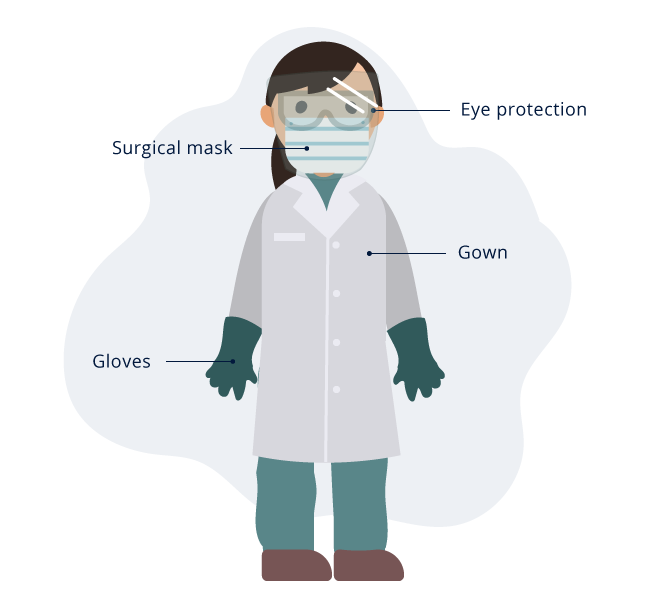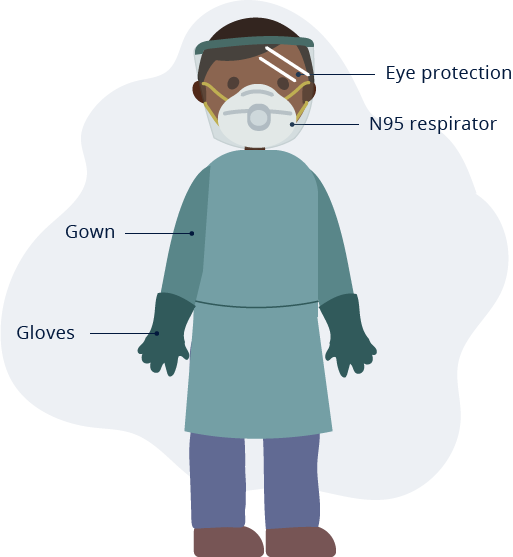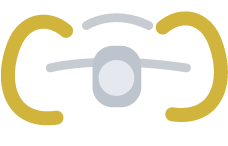PPE in Clinical Settings
How do we determine whether PPE is necessary?
To determine whether PPE is necessary, a point-of-care risk assessment (PCRA) is performed. In a PCRA, the infectious risks that a patient, situation, or procedure poses to individuals, other HCPs, other patients, and visitors are assessed. A PCRA is based on a health care team’s professional judgment about the clinical situation, as well as up-to-date information on how the specific healthcare facility has designed and implemented physical (engineering) and administrative controls, and the use and availability of PPE.
Performing a PCRA is important for avoiding PPE over-reliance, misuse, or waste.1
Before participating in or observing a clinical procedure, ask yourself or your preceptor:
- Is there a risk of splashing?
- Is there a risk of droplets spraying into my face?
- Will my clothes get soiled?
- Is there a risk of contact with blood or bodily fluids?
Some examples of common settings where additional PPE (e.g. face shields, eye protection) could be considered are: assisting childbirth, irrigating wounds, administering anaesthetics, and observing and participating in surgeries. This is not an exhaustive list!
PPE may also be required in care locations when mandated by the Ministry of Health. Over the last few years during respiratory season, additional controls like universal masking in care areas has been implemented to prevent the spread of illness.
On Friday, March 28, Dr. Bonnie Henry announced the end of the 2024/25 respiratory illness season in British Columbia. As per the updated Ministry of Health Policy, masking is no longer required for all people working in patient care areas.
Masking rules will continue to follow local Health Authority policy, including infection prevention and control guidance and point of care risk assessments.1,2
How do we determine which PPE is necessary?
After a PCRA deems PPE necessary for a clinical encounter, federal, provincial, and local guidelines should be considered next to determine which PPE must be used. PPE guidelines do not replace clinical judgement. Attending staff or clinical supervisors should always evaluate whether the PPE proposed by federal, provincial, and local guidelines is appropriate for the task they will be performing.1 Clinical judgement/PCRA takes precedence over any other guidance or recommendations pertaining to PPE usage.
General PPE Guidance for Patient Care
HCPs must follow provincial policy for infection prevention and control measures in health care settings, as applicable, for example, during viral respiratory illness (VRI) season.
When in contact with patients deemed at risk for having a VRI, implement droplet and contact precautions, which includes wearing3:
- Gloves
- Medical (surgical/procedure) mask
- Eye protection
- Gowns

During aerosol generating medical procedures (AGMPs) on patients suspected or confirmed to have infections that can potentially spread through aerosolization (e.g., COVID-19, circulating novel respiratory viruses), HCPs wear the following PPE3:
- Fit-tested respirator (N95 respirator or equivalent)
- Eye protection
- Gloves
- Gown

AGMPs may generate aerosols in high concentrations, which could contain infectious particles. This presents a risk for possible inhalation of the virus by individuals in the room where the AGMP is performed.4
In British Columbia, the classification of a medical procedure as an AGMP is determined by the Provincial AGMP Expert Working Group. Its purpose is to:
- Review medical procedures requested by clinicians that are performed on patients with suspected (i.e., with COVID-19 risks) or confirmed COVID-19 in health-care settings to determine if the procedures are AGMPs; and,
- Maintain and update the provincial list of AGMPs as needed4
Any additional PPE required other than the items listed above will be determined by the PCRA.
A Note about N95s:

If you have an existing N95 respirator certification, you must only use the model on which you have been successfully tested5. If you will be using N95s, please ensure that the model you have been tested is available at your worksite. If you need to be tested to a new model, contact the Faculty of Medicine Health & Safety team at fom.safety@ubc.ca.